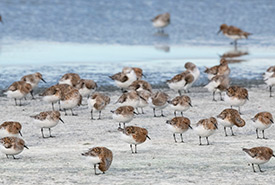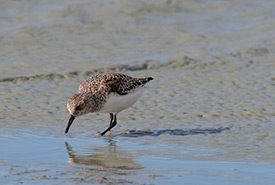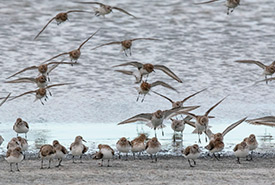Sanderlings flock to Mackie Ranch

Sanderlings (Photo by Jason bantle)
For the last blog of my internship with the Nature Conservancy of Canada (NCC), I chose to write about adorable birds that spend a lot of time in the sand: sanderlings. In fact, a flock of sanderlings is called a grain, which is a perfect name for these birds.
Sanderlings are medium-size birds, with adults reaching around 20 centimetres in length. They are part of the sandpiper family and can live up to 13 years. Their diet consists primarily of aquatic invertebrates and, like most sandpipers, sanderlings chase the waves along beaches to find food that has been carried ashore by wave action. As the waves retreat, sanderlings spot and scoop up prey that have been carried ashore. Sanderlings will also probe the wet sand and mud with their beak in search of prey and will also skim insects off the surface of shallow pools of water or catch them in mid-air. They will also eat plants when no animal prey is available.

Sanderling at Mackie Ranch (Photo by Jason Bantle)
Sanderlings occupy beaches, shorelines, and tidal and mud flats. During their spring migration, over half of the world’s population of sanderlings stop to rest and feed at Chaplin Lake in Saskatchewan. This lake is the second largest saline lake in Canada and is known for its remarkable birdwatching opportunities. The NCC’s Mackie Ranch property, located along the eastern shoreline of Chaplin Lake, falls within the boundaries of the Chaplin-Old Wives-Reed Lakes Western Hemisphere Shorebird Reserve Network site. This site is one of only three in Canada with the designation of hemispheric importance to shorebirds, and the only one that is located inland. More than 30 other species of shorebirds also visit the lake, including semipalmated sandpiper, Baird’s sandpiper, red knot and piping plover.

Sanderlings at Mackie Ranch, SK (Photo by Jason Bantle)
The Mackie Ranch property features 646 hectares of endangered grasslands and wetlands. The property and surrounding area are home to many plants and animals, including sharp-tailed grouse, Saskatchewan’s provincial bird. There are at least two active mating leks on the ranch, and at least two others on neighbouring lands. The area also provides habitat for at-risk species, including chestnut-collared longspur, ferruginous hawk and long-billed curlew. Grasslands are also important because they absorb and store billions of tonnes of carbon, provide protection from flooding and drought, and help purify our water. NCC is working to expand the Mackie Ranch conservation project, to include an additional 640 hectares of this remarkable habitat. To learn more, or to donate, visit conservegrasslands.ca.

